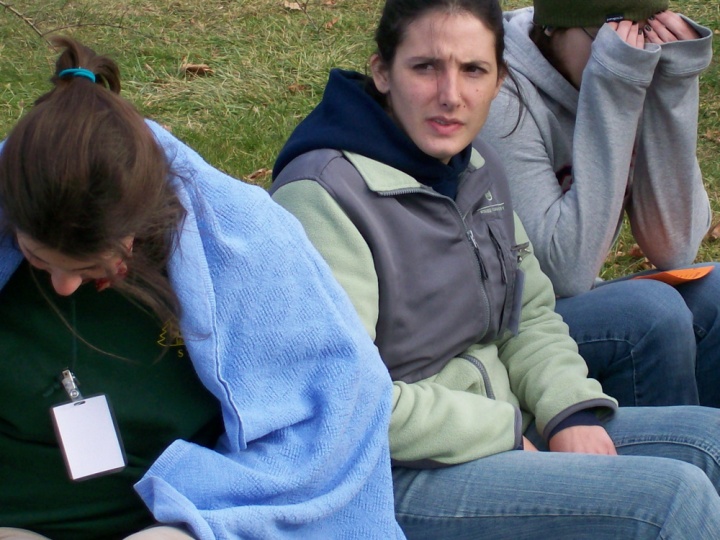Staging Trauma
Journalism professor Dan Williams describes how Lyndon State College in Vermont uses innovative disaster-simulation exercises to train journalism students.

Pre-planned trauma reporting exercises are quickly becoming more popular in U.S. college journalism programs. Constructed to provide journalism students with “real-life” trauma scenarios in which they can practice their reporting skills, these programs can successfully train prospective journalists how to handle crisis situations in difficult, chaotic environments. At Lyndon State College in Vermont, a trauma disaster program created by Dan Williams, assistant journalism professor in the Department of English, Philosophy, and Film Studies, and Margaret (Peggy) Sherrer, assistant professor in the Psychology and Human Services Department, will see its third installment on April 30, 2010. These scripted exercises are designed to look as real as possible. Generous amounts of fake blood are used, and local police and law enforcement perform their duties just as they would during a real disaster. (For Williams’ extended description of the program, see Why Wait for Disaster).
As originally conceived by Williams and Sherrer, the disaster scenarios at Lyndon State were designed to help psychology and journalism students learn how to deal with the traumatic events they can expect to encounter on the job. In reality, the benefits have gone even further. Local law enforcement has been able to use these exercises to practice new holistic disaster response programs and practice everything ranging from triage to crowd control and media response. The idea is to give all persons who are involved in traumatic disasters the skills to handle the situation before a real disaster occurs. Williams hopes to make this type of program readily available throughout Vermont.
“Disaster exercises are win-win events for all parties. They prepare police officers, firefighters and paramedics for the unexpected and make a town a safer place,” Williams says. “Putting a college in the mix helps the school tweak its emergency response plan. It also opens up new educational avenues. A theater department can supply actors, a journalism program can supply reporters, an emergency management department can provide exercise monitors, and a psychology department can add a trauma training layer. Given the right planning, much of a newsroom’s staff could take part – and come away better equipped to handle the next tragedy to strike the town.”
In a recent interview, Williams answered questions about the nuances of this program:
Chris Heide: What have you learned about staging these events?
Dan Williams: I wouldn't be able to do them properly without my colleague, Peggy Sherrer, and her background in traumatic stress. The exercise and the class leading up to it are ideal opportunities for interdisciplinary cooperation. The events also cause a big splash on a small campus like ours.
CH: What problems have you encountered?
DW: The first time we taught the class, Peggy's psychology and human services students clashed with my journalism students. It was less of a problem than an interesting insight into the way each group viewed the other. It wasn't an issue the second time we taught the class. In the second exercise, one of the student actors showed up still drunk from the night before. Maybe holding the exercise on the day after Halloween wasn't such a brilliant idea.
CH: What is the approximate budget for these exercises?
DW: Our first exercise had a budget of zero. The Vermont Homeland Security unit helped out with the second exercise, by putting up about $2,000 for overtime for about 10 state police officers, including the bomb squad, and about $400 for food. I'm not sure how much of that total was federal funds, because Vermont Homeland Security didn't break it down for us. For future exercises, we have come up with the following budget:
-
State Police $2,000 (10 officers @ $200)
-
Firefighters $1,000 (10 firefighters @ $100; most are volunteers here, and we haven't paid them in the past)
-
Rescue $1,000 (10 paramedics @ 100; we haven't paid them in the past)
-
Actors $500 (10 @ $50; these people would train our volunteer actors and participate themselves)
-
Food $750 (50 @ $15)
-
Mental health expert $150
-
In addition, we want to purchase a casualty simulation kit for $700, and spend $1,500 on ID vests for participants (75 @ $20).
CH: How long does planning, recruiting, training take?
DW: Planning for the April 30, 2010, exercise began last summer. We recruit the volunteer actors in the month before the exercise. Their training has consisted of a brief session on the day of the exercise in which we hand out sheets of paper with each actor's role and/or symptoms. We want to do a separate training session in the future.
CH: What role plays have worked well? Which ones are not? Are you willing to share examples?
DW: Our first was a dormitory fire, and our second was an "active shooter." I think the dormitory fire scenario was the better of the two, at least for the journalism students. For both exercises, we used an idea that Peggy Sherrer came up with, which was to give each of the actors a backstory. For instance, one of the fire "witnesses" survived a fire as a child and was retraumatized by the dorm blaze. Another witness had just quit using cocaine and really, really wanted some. We also assigned each volunteer actor a specific level of media accessibility -- i.e., some refused to respond to reporters, some reluctantly agreed to talk, and others sought out journalists to talk to.
CH: Any traumatic effects on students? How were they handled?
DW: Peggy hands out a psychological inventory in the introductory session of the class to help students determine how vulnerable they might be to traumatic stress. We tell them to talk to us if they are concerned. We also give them tips for self-care.
































































































